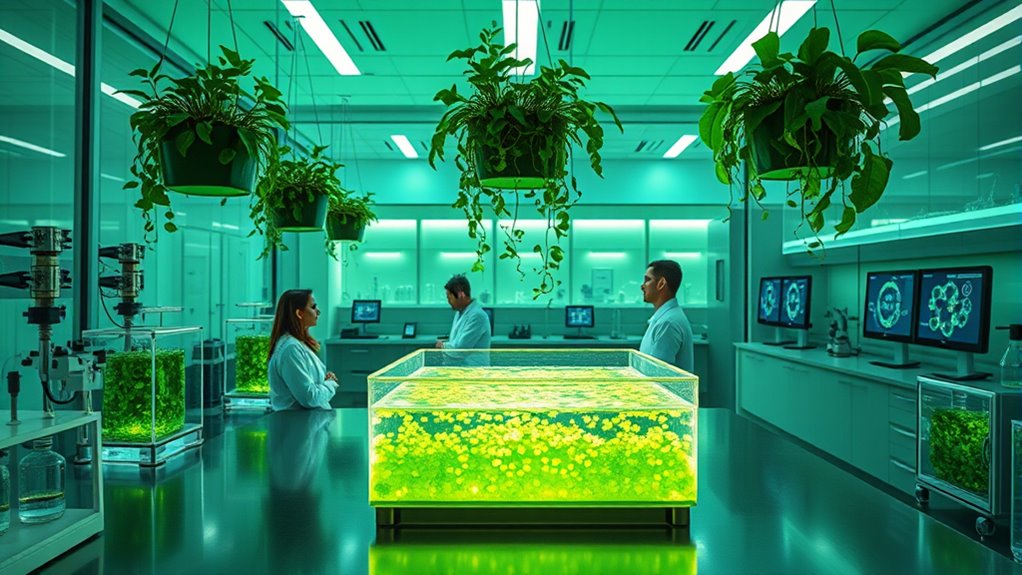Green nanotechnology helps you create sustainable industries by using eco-friendly methods to develop nanomaterials. It leverages natural extracts, plant oils, and benign solvents, reducing harmful waste and energy use. These sustainable approaches support applications like water purification, renewable energy, and biodegradable sensors. Embracing this technology minimizes environmental impact and promotes safer, more efficient products. If you explore further, you’ll discover how these innovations can transform industries toward a greener future.
Key Takeaways
- Green nanotechnology employs eco-friendly methods, utilizing natural extracts and benign solvents to produce sustainable nanomaterials.
- It reduces environmental impact by minimizing toxic waste, conserving resources, and lowering carbon emissions during synthesis.
- Eco-friendly nanomaterials enhance industries like water purification, renewable energy, and pollution control with biodegradable and efficient solutions.
- Adoption of green techniques promotes safer production, handling, and disposal, supporting safer consumer and worker environments.
- Integrating green nanotech advances industry sustainability goals, fostering innovation while preserving ecological health for future generations.

Have you ever wondered how cutting-edge technology can benefit the environment? Green nanotechnology offers innovative solutions that merge scientific advancement with sustainability. One of the fundamental aspects of this field is nanomaterial synthesis, which focuses on creating nanomaterials using eco-friendly methods. Instead of relying on toxic chemicals or energy-intensive processes, green nanomaterial synthesis employs natural extracts, plant-based reagents, and benign solvents. This approach reduces environmental impact while producing high-quality nanomaterials suitable for various applications. Imagine harnessing the power of sunlight, plant oils, or algae to generate nanostructures that can be used in water purification, energy storage, or pollution control. This shift toward sustainable synthesis methods not only minimizes harmful waste but also conserves resources, making the entire process more eco-friendly.
Green nanomaterial synthesis uses eco-friendly methods like natural extracts and benign solvents to create sustainable nanostructures.
Your role as a researcher or industry stakeholder becomes vital in advancing this field. By opting for environmentally conscious synthesis techniques, you contribute to reducing the carbon footprint associated with nanomaterial production. Eco-friendly applications of these nanomaterials span diverse sectors, from medicine to manufacturing. For instance, nanoparticles synthesized through green methods can be used to develop biodegradable sensors, more efficient catalysts, or antimicrobial coatings that do not release toxic substances into the environment. These applications demonstrate how nanotechnology, when aligned with sustainability principles, can tackle pressing environmental issues rather than exacerbate them.
Furthermore, green nanotechnology promotes the development of sustainable products that deliver long-term benefits. For example, nanomaterials integrated into solar panels or batteries enhance energy efficiency while avoiding hazardous chemicals. This means you can support industries that prioritize renewable energy and reduce reliance on fossil fuels. The eco-friendly nature of these nanomaterials ensures they are safer for workers and consumers alike, as well as easier to dispose of or recycle. As you explore these advancements, you’ll find that the focus on eco-friendly applications helps bridge the gap between technological innovation and environmental preservation.
In addition, an understanding of nanomaterial synthesis techniques is crucial for ensuring that these innovations are truly sustainable and scalable. This integration of nanomaterial synthesis with eco-friendly applications paves the way for a more sustainable industry. It empowers you to participate in developing products and processes that are both cutting-edge and environmentally responsible. By embracing green nanotechnology, you help create a future where technological progress and ecological health go hand in hand, ensuring a cleaner, healthier planet for generations to come.
Frequently Asked Questions
What Are the Potential Long-Term Environmental Impacts of Green Nanotech?
You might wonder about the long-term environmental impacts of green nanotech. While it aims to reduce resource depletion and minimize ecosystem disruption, there’s still a chance that nanomaterials could accumulate or release toxins over time. If not carefully managed, these effects could harm ecosystems and deplete natural resources. Monitoring and proper regulation are vital to guarantee green nanotechnology remains sustainable, avoiding unintended environmental consequences in the future.
How Cost-Effective Is Green Nanotechnology Compared to Traditional Methods?
You’ll find green nanotechnology more cost-effective than traditional methods because it offers significant cost savings through reduced resource use, energy efficiency, and lower waste disposal costs. The investment benefits include long-term savings, sustainability incentives, and enhanced competitiveness. While initial costs might be higher, the overall financial advantages grow over time as you benefit from innovative solutions that cut expenses and support your commitment to eco-friendly practices.
Are There Any Health Risks Associated With Green Nanomaterials?
You should be aware that nanomaterial toxicity can pose risks to human health. While green nanomaterials are designed to be safer, potential health risks still exist if these materials are inhaled or come into contact with skin. It’s important to follow safety guidelines during manufacturing and handling. Researchers continue to study nanomaterial toxicity to make certain that green nanotechnology remains a safer alternative, but caution is always advised.
How Scalable Are Green Nanotech Solutions for Industrial Applications?
You can think of green nanotech solutions like eco-friendly water filters; they’re quite scalable for industrial integration. However, scalability challenges exist due to costs, manufacturing processes, and ensuring consistent quality. For example, a hypothetical plant might struggle to incorporate green nanomaterials into large-scale production without significant investment. Despite these hurdles, ongoing research aims to improve scalability, making green nanotech more practical for widespread industrial use.
What Policies Support the Adoption of Green Nanotechnology in Industry?
You can benefit from policies that support green nanotechnology by leveraging regulatory frameworks that promote environmentally friendly innovations and guarantee safety standards. Funding incentives, such as grants and tax credits, encourage industry adoption by reducing financial risks. These policies create a conducive environment for you to integrate green nanotech solutions, accelerating sustainable practices and fostering industry growth while minimizing environmental impact.
Conclusion
By embracing green nanotechnology, you’re taking a giant leap toward a sustainable future. It’s not just about small particles; it’s about big impacts on our environment and industry. When you prioritize eco-friendly innovations, you’re killing two birds with one stone—boosting economic growth while protecting the planet. So, don’t wait for another sign; now’s the time to act and turn the tide in favor of a greener, more sustainable world.









